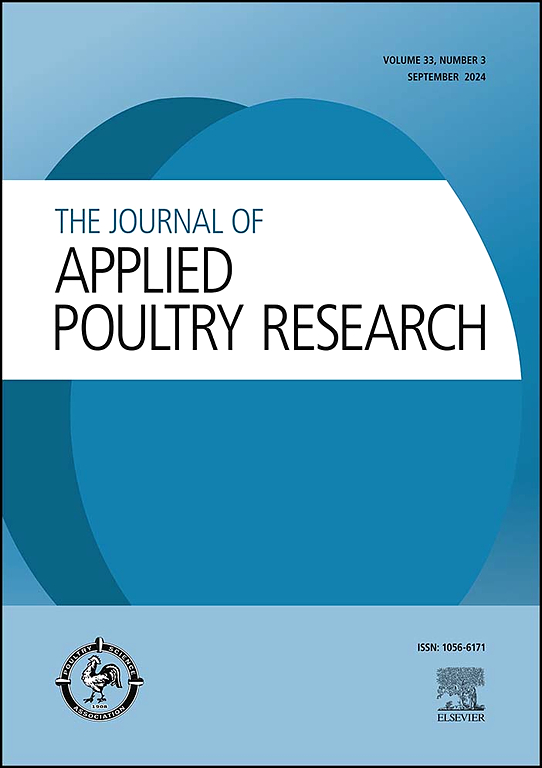优化雄性肉鸡的日粮能量和氨基酸密度:对性能、成本效益和胴体质量的影响
IF 2
3区 农林科学
Q2 AGRICULTURE, DAIRY & ANIMAL SCIENCE
引用次数: 0
摘要
日粮代谢能(ME)和氨基酸(AA)密度不仅是关键性能指标的驱动因素,而且占饲料总成本的 90% 以上。因此,优化 ME 和 AA 水平是提高成本效益的一种战略方法。本研究调查了在不同生长阶段操纵 ME 和 AA 水平如何影响 Ross 308 雄性肉鸡的性能和胴体产量。标准日粮(T1)遵循安伟捷 2022 建议,同时采用六种不同 ME 和 AA 水平的处理方法:T2:初生雏鸡的 ME 减少 100 千卡/千克,生长雏鸡的 ME 减少 75 千卡/千克;T3:与 T2 相似,但戒断期的 ME 增加 50 千卡/千克;T4:初生雏鸡的 ME 减少 100 千卡/千克,AA 增加 +4%,生长雏鸡的 ME 减少 75 千卡/千克;T5:与 T4 相似,但退奶时 ME 增加 50 千卡/千克;T6:初生犊牛 ME 减少 100 千卡/千克,AA 增加 +4%,生长犊牛 ME 减少 75 千卡/千克,AA 增加 +3%,育成犊牛 ME 减少 50 千卡/千克;T7:与 T6 相似,退奶时 ME 增加 50 千卡/千克。最终体重、FI 和 FCR 受 ME 和 AA 密度的影响不大。初生期和生长期降低 ME 的日粮使每公斤体重的饲料成本最低。不同处理的胴体性状没有差异。总之,在初生期和生长期将日粮 ME 分别降低 100 千卡/千克和 75 千卡/千克有可能降低饲料成本,而不会对生产率和胴体性状产生不利影响。本文章由计算机程序翻译,如有差异,请以英文原文为准。
Optimizing dietary energy and amino acid densities in male broiler chickens: Impacts on performance, cost efficiency, and carcass quality
Dietary metabolizable energy (ME) and amino acid (AA) densities not only drive key performance metrics but also constitute over 90% of total feed costs. Optimizing ME and AA levels is thus a strategic approach to enhancing cost-effectiveness. This study investigated how manipulating ME and AA levels at different growth phases affects Ross 308 male broiler chicks' performance and carcass yield. The standard diet (T1) followed Aviagen 2022 recommendations, while six treatments with varying ME and AA levels were administered: T2: reduced ME by 100 Kcal/kg in starter and 75 Kcal/kg in grower; T3: similar to T2 but with a 50 Kcal/kg ME increase in withdrawal; T4: reduced ME by 100 Kcal/kg and +4% AA increase in starter, with reduced ME by 75 Kcal/kg in grower; T5: similar to T4 but with a 50 Kcal/kg ME increase in withdrawal; T6: reduced ME by 100 Kcal/kg and +4% AA increase in starter, reduced ME by 75 Kcal/kg and +3% AA increase in grower, and reduced ME by 50 Kcal/kg in finisher; T7: similar to T6 with a 50 Kcal/kg ME increase in withdrawal. Final BW, FI, and FCR were not significantly affected by ME and AA densities. Diets with reduced ME in the starter and grower phases resulted in the lowest feed cost per kg of BW. Carcass traits did not differ across treatments. In conclusion, reducing dietary ME by 100 and 75 Kcal/kg in starter and grower phases, respectively, can potentially lower feed costs without adversely affecting productivity and carcass traits.
求助全文
通过发布文献求助,成功后即可免费获取论文全文。
去求助
来源期刊

Journal of Applied Poultry Research
农林科学-奶制品与动物科学
CiteScore
4.10
自引率
10.50%
发文量
80
审稿时长
104 days
期刊介绍:
The Journal of Applied Poultry Research (JAPR) publishes original research reports, field reports, and reviews on breeding, hatching, health and disease, layer management, meat bird processing and products, meat bird management, microbiology, food safety, nutrition, environment, sanitation, welfare, and economics. As of January 2020, JAPR will become an Open Access journal with no subscription charges, meaning authors who publish here can make their research immediately, permanently, and freely accessible worldwide while retaining copyright to their work. Papers submitted for publication after October 1, 2019 will be published as Open Access papers.
The readers of JAPR are in education, extension, industry, and government, including research, teaching, administration, veterinary medicine, management, production, quality assurance, product development, and technical services. Nutritionists, breeder flock supervisors, production managers, microbiologists, laboratory personnel, food safety and sanitation managers, poultry processing managers, feed manufacturers, and egg producers use JAPR to keep up with current applied poultry research.
 求助内容:
求助内容: 应助结果提醒方式:
应助结果提醒方式:


